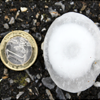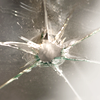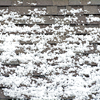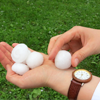For most homeowners, sitting out on a recliner on your front porch during a thunderstorm is considered calming and relaxing. Unfortunately though, sometimes those thunderstorms have cumulonimbus clouds that drop pellets of frozen rain. Yes, we are talking about hailstones, and they can lead to serious property damage. Hailstones, or hail pellets, are layers of ice and water that fall out of the sky and come in all different shapes and sizes.
What in the Hail?

Hailstorms can damage crops, vehicles, and your house, and while obvious, many are unaware of how large hailstones can be. Hailstone sizes range anywhere from ¼ of an inch to 4 ½ inches in diameter. That is equivalent to the size of a pea (¼ inch) and the size of a softball (4 ½ inch). Yikes! Average hailstorms typically have pellets ranging from ¾ of an inch or smaller, comparable to the size of a nickel. Often this fact leads to little concern from homeowners, however hailstones the size of nickels can be damaging, especially when they are falling anywhere from 8,000 to 10,000 feet at speeds of 120 mph.
During a hailstorm, your house is susceptible to damage with your roof being at most risk. It is important to check for hail damage immediately after a hailstorm has occurred. You should also inspect your siding, windows, rain gutters, and roof to see if any repairs are needed.
From the Window to the Wall, to the Hailstones that will Fall

Hail damage to your home’s windows and siding will usually be more obvious, as these damages are more visible to the eye. Cracks and chips in windows are not uncommon, and if not treated right away, they will become worse over time. Hailstones can also dent and puncture your house’s siding. During severe storms, with hailstones greater than 1 inch in diameter (size of a quarter), the hailstones can punch holes through your siding, leaving you in immediate need of exterior restoration services. Not only are your windows and siding victims to hail damage, but your rain gutters can also be dented or loosened from this menace of a storm.
Your Roof is Saying “Hail No” to Being Ignored

The most common part of your house that receives the least attention when it comes to maintenance is your roof. Ironically enough, this gets hit the hardest and takes on the most demanding weather conditions like hailstorms. To identify hail damage to your roof, you can look at the shingles to see if there are any dents, missing granules, or circular cracking. Dents will often be soft, which can lead to a weak roof down the road. Granules on roof shingles are essentially the protectors of your roof shingles. If they are missing due to hail damage, your roof will not be able to handle harsher weather conditions in the future. Any of these issues that have gone untreated can lead to more than just exterior repairs, as in some cases, a new roof is needed.
All Hail the Prepared

If you are still thinking, “what’s the big deal?” look at it this way, you wouldn’t want someone throwing a stone at your car or house because of the potential damages, so why wouldn’t you be concerned about the dangers of a hailstorm? Don’t underestimate the power behind an itty, bitty hailstone. While some are smaller in size, they can form to be as large as softballs and create extreme problems.
